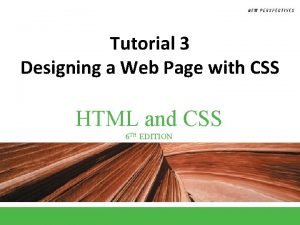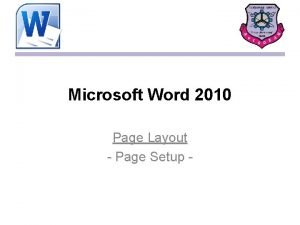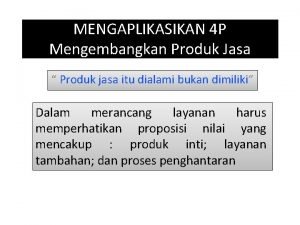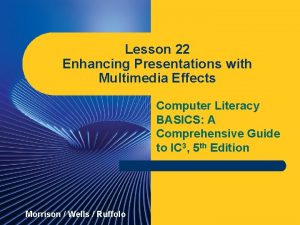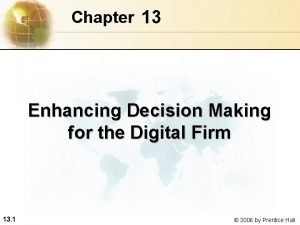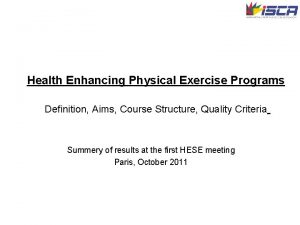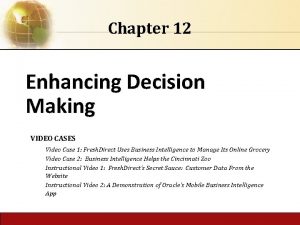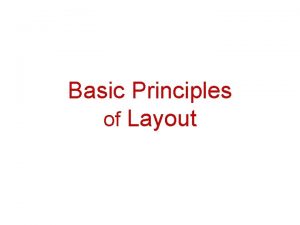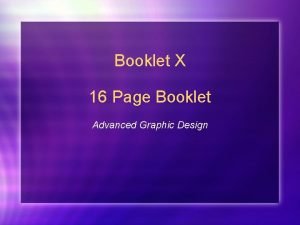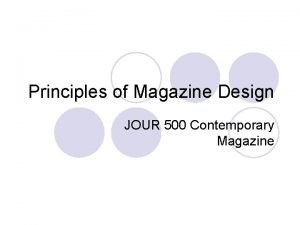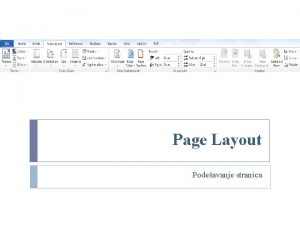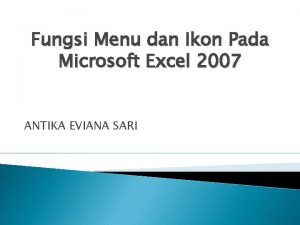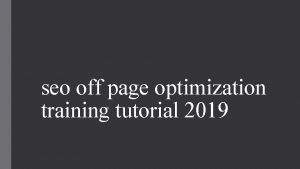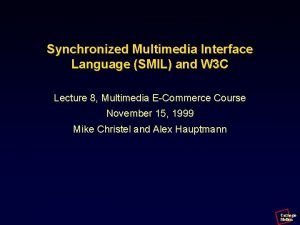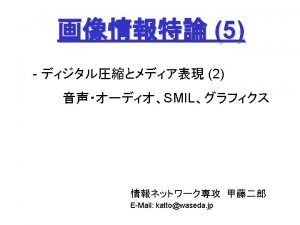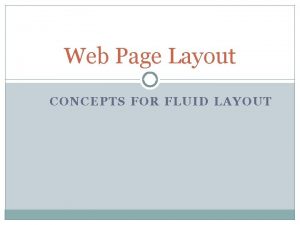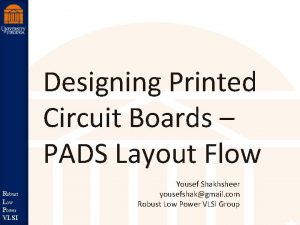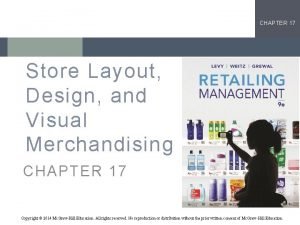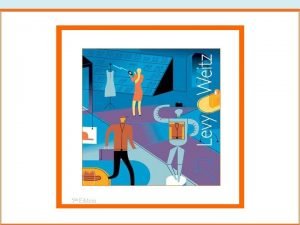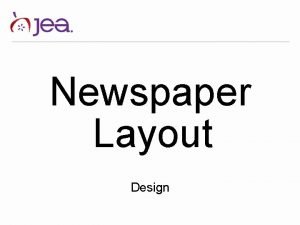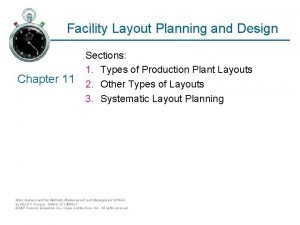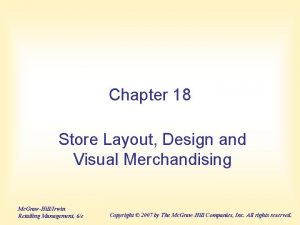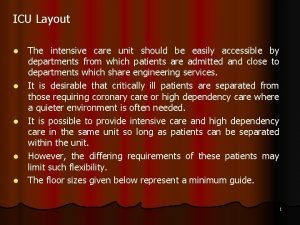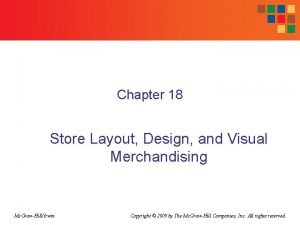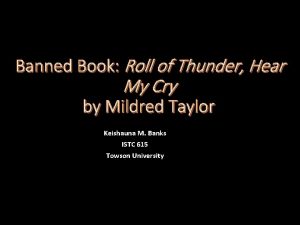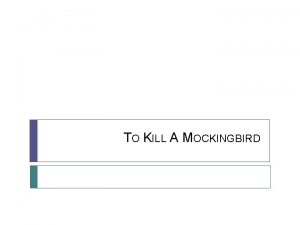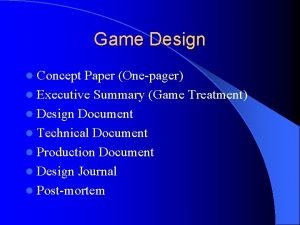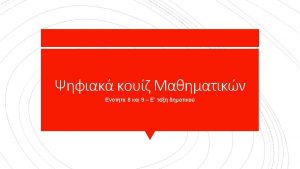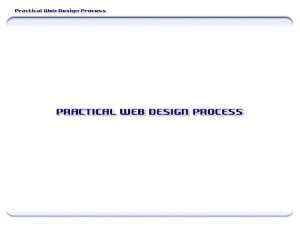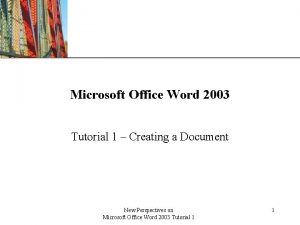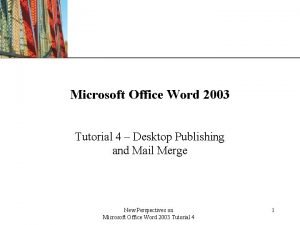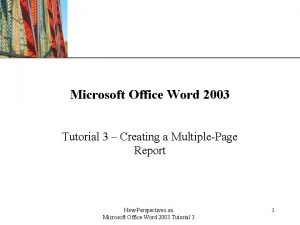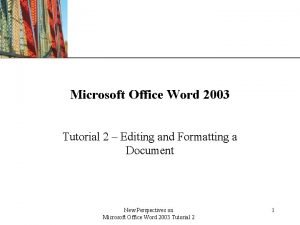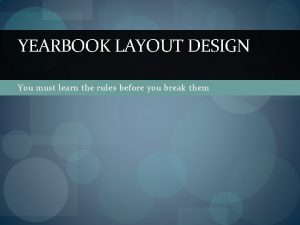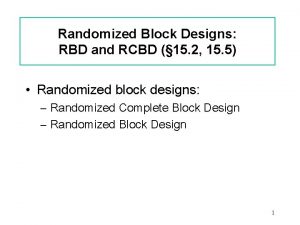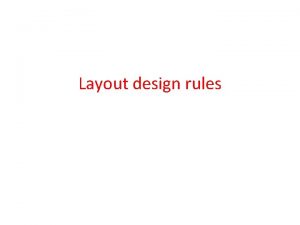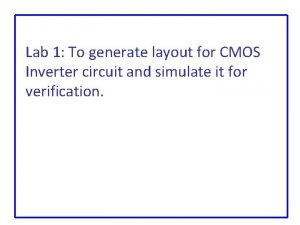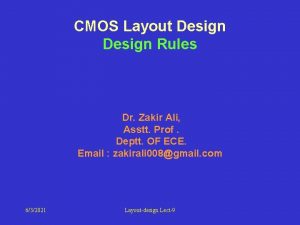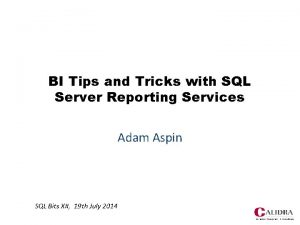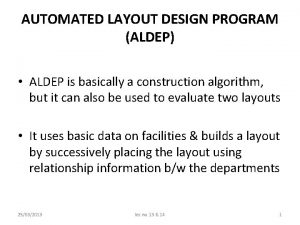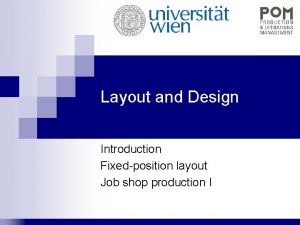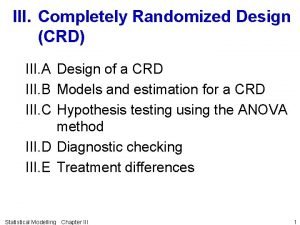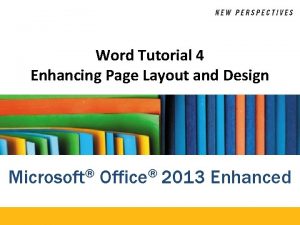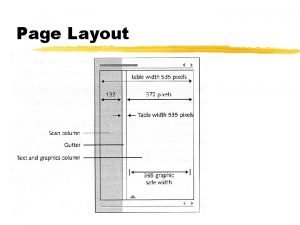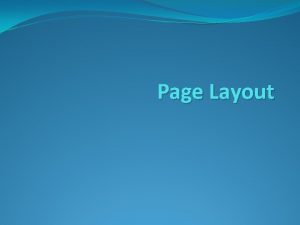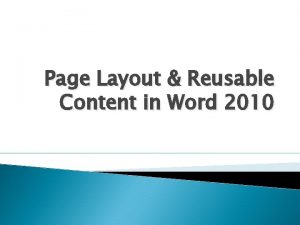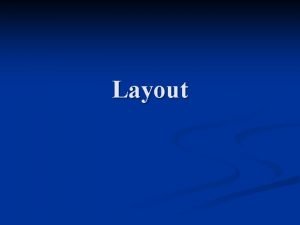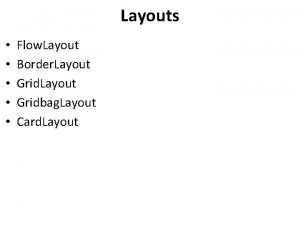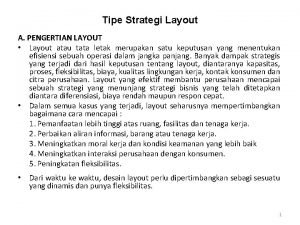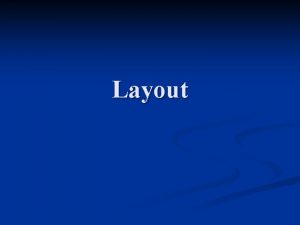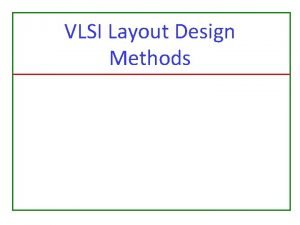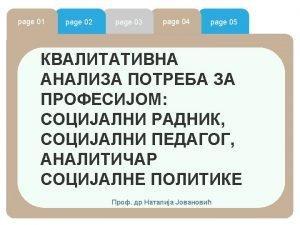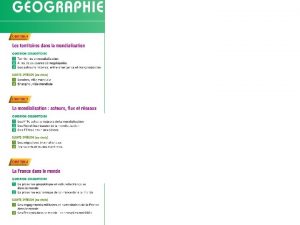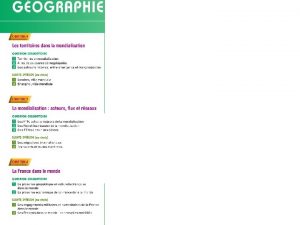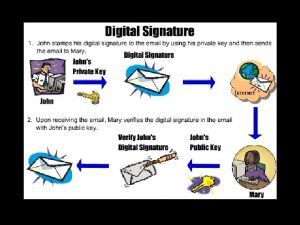Word Tutorial 4 Enhancing Page Layout and Design




























































- Slides: 60

Word Tutorial 4 Enhancing Page Layout and Design Microsoft Office 2013 ® ®

Objectives, Part 1 • • XP Use continuous section break for page layout Format text in columns Insert symbols and special characters Distinguish between inline and floating objects Wrap text around an object Insert and format text boxes Insert drop caps New Perspectives on Microsoft Word 2013 2

Objectives, Part 2 • • • XP Create and modify Word. Art Insert and crop a picture Add clip art to a document Rotate and adjust a picture Remove a photo’s background Balance columns Add a page border Save a document as a PDF Open a PDF in Word New Perspectives on Microsoft Word 2013 3

Visual Overview: Elements of Desktop Publishing, Part 1 New Perspectives on Microsoft Word 2013 XP 4

Visual Overview: Elements of Desktop Publishing, Part 2 New Perspectives on Microsoft Word 2013 XP 5

Using Continuous Section Breaks to Enhance Page Layout, Part 1 XP • Continuous section breaks start a new section without starting a new page • Sections allow you to apply different page layout settings to different parts of a page New Perspectives on Microsoft Word 2013 6

Using Continuous Section Breaks to Enhance Page Layout, Part 2 XP • In the Page Setup group of the PAGE LAYOUT tab, click the Breaks button, and then click Continuous New Perspectives on Microsoft Word 2013 7

Formatting Text in Columns, Part 1 XP • Text meant for quick reading is often laid out in columns • Click the PAGE LAYOUT tab, and then, in the Page Setup group, click the Columns button New Perspectives on Microsoft Word 2013 8

Formatting Text in Columns, Part 2 XP New Perspectives on Microsoft Word 2013 9

Inserting Symbols and Special Characters, Part 1 XP • When creating documents in Word, you can change some of the characters available on the standard keyboard into more polished-looking characters called typographic characters. Common typographic characters To insert this symbol or character Em dash Smiley face Type Word converts to Word--word—word : ) Copyright symbol Trademark symbol (c) (tm) © ™ Registered trademark symbol (r) ® Fractions 1/2, 1/4 ½, ¼ Arrows <-- or --> or New Perspectives on Microsoft Word 2013 10

Inserting Symbols and Special Characters, Part 2 XP • To insert a symbol or special character: – Move the insertion point to the location where you want to insert a particular symbol or special character – Click the Insert tab, and then, in the Symbols group, click the Symbol button – If you see the symbol or character you want in the Symbol gallery, click it; for a more extensive set of choices, click More Symbols to open the Symbol dialog box – In the Symbol dialog box, locate the symbol or character you want on either the Symbols tab or the Special Characters tab – Click the symbol or special character you want, click the Insert button, and then click the Close button New Perspectives on Microsoft Word 2013 11

Inserting Symbols and Special Characters, Part 3 XP • Word’s Auto. Correct feature automatically converts some standard characters into typographic characters as you type New Perspectives on Microsoft Word 2013 12

Introduction to Working with Objects, Part 1 XP • Inserting Graphic Objects – Objects used for illustration purposes or to enhance the page layout are sometimes called graphic objects, or simply graphics – The INSERT tab is the starting point for adding graphics to a document – After inserting a graphic object, you need to adjust its position on the page – Your ability to control the position of an object depends on whether it is an inline object or a floating object New Perspectives on Microsoft Word 2013 13

Introduction to Working with Objects, Part 2 XP • Distinguishing Between Inline and Floating Objects – An inline object behaves as if it were text; like an individual letter, it has a specific location within a line of text, and its position changes as you add or delete text – You can position a floating object anywhere on the page, with the text flowing, or wrapping, around it – A floating object is attached, or anchored, to an entire paragraph—so if you delete that paragraph, you will also delete the object New Perspectives on Microsoft Word 2013 14

Introduction to Working with Objects, Part 3 XP – You can align an inline object just as you would align text – You can move a floating object independently of that paragraph New Perspectives on Microsoft Word 2013 15

Introduction to Working with Objects, Part 4 XP • Wrapping Text Around an Object – To transform an inline object into a floating object, apply a text wrapping setting to it – Click the object to select it, click the Layout Options button next to the object, and then click an option in the Layout Options gallery New Perspectives on Microsoft Word 2013 16

Introduction to Working with Objects, Part 5 XP • Wrapping Text Around an Object Menu Icon Type of Wrapping Description An image of horizontal lines surrounding a square area Square containing a shaded arc. Text flows in a square outline around the object, regardless of the shape of the object; by default, Square text wrapping is applied to preformat-ted text boxes inserted via the Text Box button on the INSERT tab. An image containing a shaded arc with horizontal lines Tight completely surrounding the surface of the arc; including the inner section. Text follows the exact outline of the object; if you want the text to flow around an object; this is usually the best option. An image containing horizontal lines surrounding the outer sections but not the inner section of a shaded arc. Text flows through the object, filling up any open areas; this type is similar to Tight text wrapping. . Through An image containing horizontal lines located above and Top and Bottom below an area containing a shaded arc. There are no lines on either side of the arc. Text stops above the object and then starts again below the object. An image of an area completely filled with horizontal lines. There is a shaded arc in the background. Behind Text The object is layered behind the text, with the text flowing over it. An image of an area completely filled with horizontal lines. There is a shaded arc above the lines. In Front of Text The object is layered in front of the text, with the text flowing behind it; if you want to position an object in white space next to the text, this option gives you the greatest control over its exact position. By default, In Front of Text wrapping is applied to any shapes inserted via the Shapes button in the Illustrations group on the INSERT tab. New Perspectives on Microsoft Word 2013 17

Inserting Text Boxes, Part 1 XP • You can add a preformatted text box to a document or create your own text box from scratch • Preformatted text boxes are professional looking and, therefore, are usually a better choice than creating your own • You can alter the appearance of a text box by using the Shape Styles options on the DRAWING TOOLS FORMAT tab New Perspectives on Microsoft Word 2013 18

Inserting Text Boxes, Part 2 XP • Inserting a Preformatted Text Box – Click in the document where you want to insert the text box – On the ribbon, click the INSERT tab – In the Text group, click the Text Box button to open the Text Box gallery, and then click a text box style to select it – In the text box in the document, delete the placeholder text, type the text New Perspectives on Microsoft Word 2013 19

Inserting Text Boxes, Part 3 XP • Inserting a Preformatted Text Box – A sidebar is a text box designed to look good positioned to the side of the main document text New Perspectives on Microsoft Word 2013 20

Inserting Text Boxes, Part 4 XP • Changing the Text Wrapping Setting for the Text Box – A preformatted text box inserted via the Text box button on the INSERT tab is, by default, a floating object formatted with Square text wrapping – Use the Layout Options to gain more control over the exact position of the text box on the page New Perspectives on Microsoft Word 2013 21

Inserting Text Boxes, Part 5 New Perspectives on Microsoft Word 2013 XP 22

Inserting Text Boxes, Part 6 XP • Adding Text to a Text Box – Text boxes are used to present new information or to highlight a quote from the main document – A direct quote from a document formatted in a text box is known as a pull quote – You can copy the text from the main document, and then paste it into a text box – You can type text in a text box – You can insert text from another Word document by using the Object button arrow on the INSERT tab New Perspectives on Microsoft Word 2013 23

Inserting Text Boxes, Part 7 New Perspectives on Microsoft Word 2013 XP 24

Inserting Text Boxes, Part 8 XP • Drawing and Formatting a Text Box Using the Shapes Menu – A text box is considered a shape, just like the other shapes you can insert via the Shapes button on the INSERT tab – Text boxes are typically rectangular, but you can turn any shape into a text box – With the shape selected, type the text you want – You won’t see an insertion point inside the shape, but you can still type text inside it and then format the text New Perspectives on Microsoft Word 2013 25

Inserting Text Boxes, Part 9 New Perspectives on Microsoft Word 2013 XP 26

Inserting Text Boxes, Part 10 New Perspectives on Microsoft Word 2013 XP 27

Inserting Text Boxes, Part 11 New Perspectives on Microsoft Word 2013 XP 28

Inserting Drop Caps XP • A drop cap is a large, capital letter that begins the text of a paragraph, chapter, or some other document section • To open the Drop Cap menu, click the INSERT tab and then click the Drop Cap button in the Text group New Perspectives on Microsoft Word 2013 29

Visual Overview: Editing Pictures, XP Part 1 New Perspectives on Microsoft Word 2013 30

Visual Overview: Editing Pictures, XP Part 2 New Perspectives on Microsoft Word 2013 31

Formatting Text with Word. Art, Part 1 XP • To create special text elements, you can use decorative text known as Word. Art • Word. Art is text in a text box that is formatted with a text effect • The outline color is the exterior color of the characters • The fill color is the interior color of the characters • You can add rounded, or beveled, edges to Word. Art, format the text in 3 -D, and transform the text into waves, circles, and other shapes New Perspectives on Microsoft Word 2013 32

Formatting Text with Word. Art, Part 2 XP • To start creating Word. Art, you can select text you want to transform into Word. Art, and then click the Word. Art button in the Text group on the INSERT tab New Perspectives on Microsoft Word 2013 33

Formatting Text with Word. Art, Part 3 XP • Modifying Word. Art – When resizing Word. Art, you need to consider both the font size of the text and the size of the text box that contains the Word. Art – You change the font size for Word. Art text just as you would for ordinary text – If you choose a large font for a headline, you might also need to resize the text box to ensure that the resized text appears on a single line New Perspectives on Microsoft Word 2013 34

Formatting Text with Word. Art, Part 4 XP • Modifying Word. Art – The Transform menu displays options for changing the Word. Art’s shape New Perspectives on Microsoft Word 2013 35

Working with Pictures, Part 1 XP • A picture is a photo, drawing, or other image • You can copy and paste pictures into a document • You can insert pictures via either the Pictures button or the Online Pictures button, both located in the Illustrations group on the INSERT tab – Use the Pictures button to insert a picture from a file stored on your computer – Use the Online Pictures button to insert clip art • After you insert a picture, it functions as an object that you can move, resize, wrap text around, and edit New Perspectives on Microsoft Word 2013 36

Working with Pictures, Part 2 XP • Inserting and Cropping a Picture – You can crop part of a picture as well as use several more advanced cropping options – You can crop to a shape, which means trimming the edges of a picture so it fits into a star, an oval, an arrow, or another shape – You can crop to a specific ratio of height to width – Once you crop a picture, the part you cropped is hidden from view; it remains a part of the picture in case you change your mind and want to restore the cropped picture to its original form New Perspectives on Microsoft Word 2013 37

Working with Pictures, Part 3 New Perspectives on Microsoft Word 2013 XP 38

Working with Pictures, Part 4 XP • Searching for and Inserting Clip Art – Most clip art websites include a search box where you can type some descriptive keywords to help you narrow the selection down to a smaller range New Perspectives on Microsoft Word 2013 39

Working with Pictures, Part 5 New Perspectives on Microsoft Word 2013 XP 40

Working with Pictures, Part 6 New Perspectives on Microsoft Word 2013 XP 41

Working with Pictures, Part 7 XP • Rotating a Picture – Quickly rotate a picture by dragging the Rotation handle that appears on the photo’s border when the photo is selected – To access preset rotation options, click the Rotate button in the Arrange group to open the Rotate menu – To quickly rotate a picture 90 degrees, click Rotate Right 90° or Rotate Left 90° in the Rotate menu – Click Flip Vertical or Flip Horizontal in the Rotate menu to flip a picture New Perspectives on Microsoft Word 2013 42

Working with Pictures, Part 8 New Perspectives on Microsoft Word 2013 XP 43

Working with Pictures, Part 9 XP • Adjusting a Picture – The Adjust group on the PICTURE TOOLS FORMAT tab provides several tools for adjusting a picture’s overall look – Some, such as the Remove Background button, only work for photos – Others, such as the Color button, provide some options that work only for photos and some that work for both photos and line drawings New Perspectives on Microsoft Word 2013 44

Working with Pictures, Part 10 XP • Removing a Photo’s Background – Removing a photo’s background can be tricky, especially if you are working on a photo with a background that is not clearly differentiated from the foreground image – Start by clicking the Remove Background button in the Adjust group, and then making changes to help Word distinguish between the background that you want to exclude and the image you want to keep New Perspectives on Microsoft Word 2013 45

Working with Pictures, Part 11 New Perspectives on Microsoft Word 2013 XP 46

Working with Pictures, Part 12 XP • Removing a Photo’s Background – Select the photo, and then on the PICTURE TOOLS FORMAT tab, in the Adjust group, click the Remove Background button – Drag the handles on the border to include any parts of the photo that have been incorrectly marked for removal – To mark areas to keep, click the Mark Areas to Keep button in the Refine group on the BACKGROUND REMOVAL tab, and then use the drawing pointer to select areas to keep New Perspectives on Microsoft Word 2013 47

Working with Pictures, Part 13 New Perspectives on Microsoft Word 2013 XP 48

Working with Pictures, Part 14 XP • Removing a Photo’s Background – To mark areas to remove, click the Mark Areas to Remove button in the Refine group on the BACKGROUND REMOVAL tab, and then use the drawing pointer to select areas to remove – Click the Keep Changes button in the Close group New Perspectives on Microsoft Word 2013 49

Working with Pictures, Part 15 New Perspectives on Microsoft Word 2013 XP 50

Working with Pictures, Part 16 XP • Inserting and Editing a Clip Art Drawing – You can insert the clip art drawing by clicking the Online Pictures button in the Illustrations group on the INSERT tab and then typing some keywords New Perspectives on Microsoft Word 2013 51

Working with Pictures, Part 17 XP • Inserting and Editing a Clip Art Drawing – You can resize a drawing, apply a picture style, wrap text around it, and position it on the page New Perspectives on Microsoft Word 2013 52

Balancing Columns, Part 1 XP • To balance columns on a page, meaning to make them equal length, you can insert a continuous section break at the end of the last column • Word adjusts the flow of content between the columns so they are of equal or near equal length • The columns remain balanced no matter how much material you remove from any of the columns later • The columns also remain balanced if you add material that causes the columns to flow to a new page; the overflow will also be formatted in balanced columns New Perspectives on Microsoft Word 2013 53

Balancing Columns, Part 2 New Perspectives on Microsoft Word 2013 XP 54

Inserting a Border Around a Page XP • In the Page Background group of the DESIGN tab, click the Page Borders button to open the Borders and Shading dialog box New Perspectives on Microsoft Word 2013 55

Saving a Document as a PDF, Part 1 XP • A PDF, or Portable Document Format file, contains an image showing exactly how a document will look when printed • Because a PDF can be opened on any computer, saving a document as a PDF is a good way to ensure that it can be read by anyone • All PDFs have a file extension of. pdf • By default, PDFs open in Adobe Acrobat Reader, a free program installed on most computers for reading PDFs, or in Adobe Acrobat, a PDF-editing program available for purchase from Adobe New Perspectives on Microsoft Word 2013 56

Saving a Document as a PDF, Part XP 2 • On the ribbon, click the FILE tab • In the navigation bar, click Export to display the Export screen with Create PDF/XPS Document selected • Click the Create PDF/XPS Document button; the Publish as PDF or XPS dialog box opens • To save a document as a PDF and attach it to an email message in Outlook, click the FILE tab, click Share in the navigation bar, click Email, and then click Send as PDF New Perspectives on Microsoft Word 2013 57

Saving a Document as a PDF, Part XP 3 New Perspectives on Microsoft Word 2013 58

Converting a PDF to a Word Document, Part 1 XP • To copy text from a PDF file, drag the mouse pointer to select the text you want to copy, press the Ctrl+C keys, return to your Word document, and then press the Ctrl+V keys to paste the text into your document • To reuse the entire contents of a PDF, it is easier to convert it to a Word document – A very useful option with PDFs that consist mostly of text – For more complicated PDFs, the results are less predictable New Perspectives on Microsoft Word 2013 59

Converting a PDF to a Word Document, Part 2 XP • To open a PDF file in Word: – Click the FILE tab to display Backstage view – In the navigation bar, click Open – Click the arrow to the right of the File name box, and then click All Files – Select the PDF file, click the Open button, and then, if you see a dialog box explaining that Word is about to convert a PDF to a Word document, click the OK button New Perspectives on Microsoft Word 2013 60
 Tutorial 3 designing a page layout
Tutorial 3 designing a page layout Page layout word
Page layout word Four enhancing qualitative characteristics
Four enhancing qualitative characteristics Enhancing professional practice
Enhancing professional practice Charlotte danielson framework
Charlotte danielson framework Enhancing personal effectiveness
Enhancing personal effectiveness Enhancing supplementary services
Enhancing supplementary services Enhancing thermal conductivity of fluids with nanoparticles
Enhancing thermal conductivity of fluids with nanoparticles Enhancing the performance of grade vi-c
Enhancing the performance of grade vi-c Privacy-enhancing computation
Privacy-enhancing computation Property enhancing process in manufacturing
Property enhancing process in manufacturing Enhancing a presentation with multimedia
Enhancing a presentation with multimedia Enhancing professional practice: a framework for teaching
Enhancing professional practice: a framework for teaching Enhancing decision making
Enhancing decision making History of performance enhancing drugs
History of performance enhancing drugs Health enhancing physical activity definition
Health enhancing physical activity definition Enhancing decision making
Enhancing decision making Apa style powerpoint
Apa style powerpoint Principles of page layout
Principles of page layout 16 page booklet layout
16 page booklet layout Magazine front page layout
Magazine front page layout Tema layout
Tema layout Fungsi menu microsoft excel
Fungsi menu microsoft excel Off page optimization tutorial
Off page optimization tutorial Numerator layout vs denominator layout
Numerator layout vs denominator layout Language
Language Cddat
Cddat Fluid layout vs fixed layout
Fluid layout vs fixed layout Pads layout tutorial
Pads layout tutorial Shop layout design
Shop layout design Store planning ppt
Store planning ppt Newspaper size
Newspaper size Screen design and layout in hci
Screen design and layout in hci Closeness rating
Closeness rating Merchandising layout
Merchandising layout Icu layout and design
Icu layout and design Idea-oriented presentation
Idea-oriented presentation 6 principles of design
6 principles of design Titanic layout and design
Titanic layout and design How to change web layout in word
How to change web layout in word Roll of thunder hear my cry banned
Roll of thunder hear my cry banned Page 174 to kill a mockingbird
Page 174 to kill a mockingbird One pager game
One pager game Https forms office com pages design page aspx
Https forms office com pages design page aspx 2webdesign
2webdesign Microsoft word 2003 tutorial
Microsoft word 2003 tutorial Word 2003 tutorial
Word 2003 tutorial Microsoft word 2003 tutorial
Microsoft word 2003 tutorial Ms word 2003 tutorial
Ms word 2003 tutorial Dominant rules
Dominant rules Spss rcbd
Spss rcbd Layout shielding
Layout shielding Introduction layout design
Introduction layout design Layout of cmos inverter in vlsi
Layout of cmos inverter in vlsi Types of layout
Types of layout Cmos design rules
Cmos design rules Ssrs report design layout tricks
Ssrs report design layout tricks What is aldep
What is aldep Fixed position layout design
Fixed position layout design Crd iii
Crd iii Floor plan film
Floor plan film
